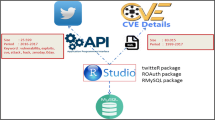Abstract
Social Digital Media become an effective platform for many cyber community to promote product and services to get reach greater potential market around the globe. However, Social Digital Media could lead to several critical cybersecurity risk that might be difficult to manage and mitigate. Moreover, some the cybersecurity risk could cause severe impact of human factors especially if the risk affected the Critical National Information Infrastructure (CNII) that serve as backbone of the country. Hence the objective of the research are to determine the human factors related of social media cybersecurity risk and; to discuss their severity level impact on Critical National Information Infrastructure (CNII). Questionnaires are distributed to various private and government agencies practitioners for the study. The finding of the research show that the top 5 most critical cybersecurity risk are Information Theft; Cyber Attacks; Cyber Crime; Information Manipulation; Productivity Loss. This article also highlight top 5 least critical cybersecurity risks which are Attack of the Software; Cyber Assault/Bullying; Espionage; Terrorisms; Risk of Losing the legal Battle. Through the findings, expert, management and practitioner would be able to identify critical cybersecurity risk and address them appropriately and effectively.
Access this chapter
Tax calculation will be finalised at checkout
Purchases are for personal use only
Similar content being viewed by others
References
Tang, Q., Gu, B., Whinston, A.B.: Content contribution for revenue sharing and reputation in social media: a dynamic structural model. J. Manag. Inf. Syst. 29(2), 41–76 (2012)
Ngai, E.W.T., Tao, S.S.C., Moon, K.K.L.: Social media research: theories, constructs, and conceptual frameworks. Int. J. Inf. Manag. 35, 33–34 (2015)
Kaplan, A.M., Haenlein, M.: Users of the world, unite! The challenges and opportunities of Social Media. Bus. Horiz. 53(1), 59–68 (2010)
Jacka, J.M., Scott, P.R.: Auditing social media: a governance and risk guide. Wiley, Hoboken (2011)
Merriam-Webster Dictionary—Social Media. http://www.merriam-webster.com/dictionary/social%20media
Colliander, J., Dahlén, M.: Following the fashionable friend: the power of social media. J. Advertising Res. 51(1), 313–320 (2011)
Hanna, R., Rohm, A., Crittenden, V.L.: We’re all connected: the power of the social media ecosystem. Bus. Horiz. 54(3), 265–273 (2011)
Hinson, G.: Top information security risk for 2008: information security risk. In: CISSP Forum, pp. 2–5, 2008
ISO/IEC 27000:2009 (E): Information technology—security techniques—information security management systems—overview and vocabulary. ISO/IEC (2009)
Best Practices in Social Networking Sites. Cyber Security Malaysia, 2011
Gasser, M.: Building a Secure Computer System (PDF), p. 3. Van Nostrand Reinhold, New York (1988). ISBN 0-442-23022-2
Online Source: Oxford English Dictionary online. Oxford University Press. Sept 2007. Archived from the original on 2012-07-08. Retrieved 27 Sept 2010
Online Source: Cyber Warfare and the Crime of Aggression: The Need for Individual Accountability on Tomorrow’s Battlefield. Law.duke.edu. Retrieved 6 Feb 2016
Anderson, R.J.: Security engineering: a guide to building dependable distributed systems, 2nd edn, p. 1040. Wiley, Indianapolis, IN. ISBN 978-0-470-06852-6 (Chap. 2, p. 17)
Greavu-Şerban, V., Şerban, O.: Social engineering a general approach. Inf. Economica J. 18(2), 2014 (2014)
Willison, R.: Understanding the perpetration of employee computer crime in the organisational context (PDF). Inf. Organ. 16, 304–324 (2006)
Online Source: Blitz, J.: Security: a huge challenge from China, Russia and organised crime. Financial Times, 1 Nov 2011. Retrieved 6 Feb 2016
Understanding Information Infrastructure. http://heim.ifi.uio.no/~oleha/Publications/bok.pdf
National Cyber Security Policy-2013: Department of Electronics & Information Technology, Government of India. http://deity.gov.in/content/national-cyber-security-policy-2013-1
Amid spying saga, India unveils cyber security policy. Times of India. INDIA. http://timesofindia.indiatimes.com/tech/enterprise-it/security/Amid-spying-saga-India-unveils-cyber-security-policy/articleshow/20885499.cms?referral=PM
National Cyber Security Policy 2013: An Assessment. Institute for Defence Studies and Analyses. http://www.idsa.in/idsacomments/NationalCyberSecurityPolicy2013_stomar_260813
For a unified cyber and telecom security policy. The Economic Times. http://articles.economictimes.indiatimes.com/2013-09-24/news/42361275_1_national-information-board-national-cyber-security-policy-state-of-the-art-security-lab
Critical National Information Infrastructure. http://cnii.cybersecurity.my/main/about.html
Cybersecurity Definition. http://whatis.techtarget.com/definition/cybersecurity
For a unified cyber and telecom security policy. http://articles.economictimes.indiatimes.com
Wikipedia, The free encyclopedia, Social Engineering. http://en.wikipedia.org
Anderson, R.J.: Security engineering: a guide to building dependable distributed systems, 2nd edn, p. 1040. Wiley, Indianapolis, IN (2008). ISBN 978-0-470-06852-6 (Chap. 2, p. 17)
Irani, D.: Reverse Social Engineering Attacks in Online Social Networks. https://en.wikipedia.org/wiki/Social_engineering_(security)
Khidzir, N.Z., Arshad, N.H., Mohamed, A.: Information security risk factors: critical threats and vulnerabilities in ICT outsourcing. In: Proceedings of International Conference on Information Retrieval and Knowledge Management (CAMP’10), 2010, pp. 194–199 [10]
Rahim, N.N, Khidzir, N.Z., Yusof, A.M., Daud, K.A.M.: Towards a conceptual framework of animated infographics in an islamic context. In: Proceedings of 1st International Islamic Heritage Conference, 2015, pp. 38–48
Author information
Authors and Affiliations
Corresponding author
Editor information
Editors and Affiliations
Rights and permissions
Copyright information
© 2016 Springer International Publishing Switzerland
About this paper
Cite this paper
Khidzir, N.Z., Ismail, A.R., Daud, K.A.M., Ghani, M.S.A.A., Ismail, S., Ibrahim, A.H. (2016). Human Factor of Online Social Media Cybersecurity Risk Impact on Critical National Information Infrastructure. In: Nicholson, D. (eds) Advances in Human Factors in Cybersecurity. Advances in Intelligent Systems and Computing, vol 501. Springer, Cham. https://doi.org/10.1007/978-3-319-41932-9_16
Download citation
DOI: https://doi.org/10.1007/978-3-319-41932-9_16
Published:
Publisher Name: Springer, Cham
Print ISBN: 978-3-319-41931-2
Online ISBN: 978-3-319-41932-9
eBook Packages: EngineeringEngineering (R0)




